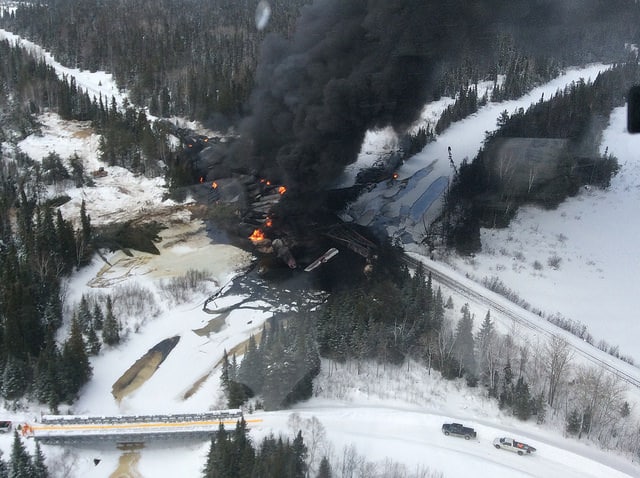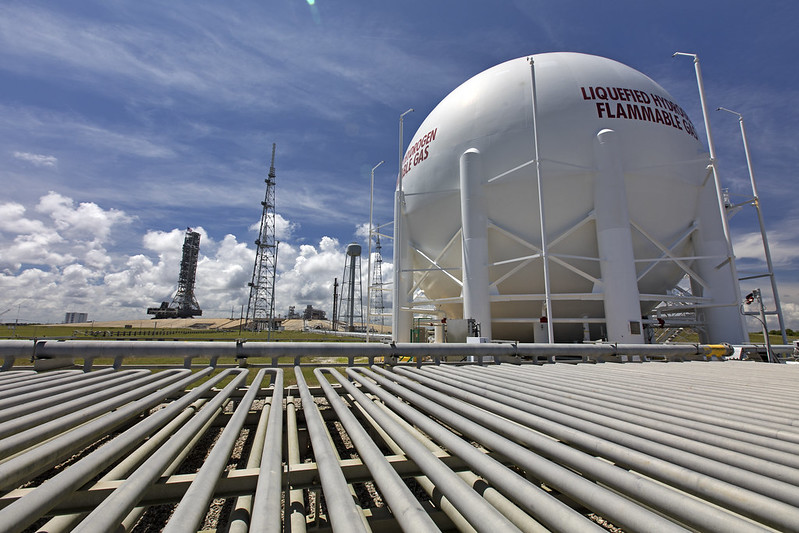When a CN train carrying crude oil derailed and caught fire last weekend near Gogama, Ontario, it became the fifth loaded oil train to leave the tracks in North America in the past two months — and it’s raising new questions about the volatility of diluted bitumen from Alberta’s oilsands.
In the March 7th accident, several cars slid into the Mattagami River and ignited, leading local officials to issue a drinking water warning for the Mattagami First Nation.
The accident comes less than a month after another CN tanker train carrying crude derailed in the same region, about 200 kilometres north of Sudbury, spilling an estimated more than one million litres of diluted bitumen into local waterways. Twenty-nine cars left the tracks, causing an explosion that left fires burning for six days.
Officials are still scrambling to clean up the oil, which has spilled into a nearby creek, pond and section of Kasasway Lake, before spring thaw.
Gogama Village Inn owner Roxanne Veronneau told the Toronto Star, “People here are on pins and needles. The tracks run right through town … I’m sure that there’s going to be a lot of talk afterward that this shouldn’t be in the middle of our town.”
“It’s frightening and nerve-wracking, especially after what happened in Quebec.”
The recent accident near Gogama is the third CN Rail derailment in Ontario in the last month and the fifth tanker train derailment continent-wide.
CN Rail experienced another tanker train derailment on March 5 near Horneypayne, Ontario. No oil spilled as a result of the derailment.
On February 16, a tanker train carrying fracked shale oil from North Dakota derailed in West Virginia, causing a spectacular explosion and forcing the evacuation of two towns. At least one of the derailed cars fell into the Kanawha River, a source of drinking water for two counties.
On March 6 a BNSF train carrying Bakken crude oil derailed south of Galena, Illinois. Twenty-one cars left the tracks and five cars ignited causing a large fireball and plumes of black smoke. Emergency responders spent three days working to bring that fire under control.
Growing Concern Over Volatility of Diluted Bitumen
The spate of recent tanker train explosions in Canada has raised concerns about the volatility of diluted bitumen, which contains highly flammable light hydrocarbons. Although the explosive qualities of Bakken oil — which was central to the tanker train disaster in Lac-Mégantic that left 47 dead — is well-documented, similar attention has not been paid to diluted bitumen, as DeSmogBlog recently reported.
As Railway Age reports, “before CN’s first Gogama wreck Feb. 14, there was a widespread and comforting belief among railroaders, regulators and, yes, even railroad reporters, that tar sands bitumen was much safer for transport by rail than light or conventional crude oils.”
“We now know, thanks to Gogama 1 and Gogama 2, that neither dilbit nor synbit, the synthetically diluted variant of tar sands oil, are safer than untreated Bakken crude.”
The hazardousness of crude oil blends is determined by its ignitability, which is determined by the blend’s most volatile component, Railway Age reports. Thus for diluted bitumen, the volatility of light hydrocarbons used as diluents is a critical factor in determining how fuel will respond in a tanker car accident.
Oil Change International recently calculated an average of 100,000 to 150,000 barrels of dilbit is loaded onto tanker trains at Alberta terminals each day.
“As it takes on average around nine days for a train to reach its destination, this means that at any given time there are between 18 and 27 trains carrying dilbit through the continent loaded with some 900,000 to 1.4 million barrels of dilbit,” Oil Change International’s Andy Rowell reports.
“Together with the roughly one million barrels per day of light, tight crude oil loaded in the Bakken and elsewhere around the continent the threat is enormous.”
Lessons Learned in Lac-Mégantic Not Enough
After the disaster in Lac-Mégantic, Transport Canada ordered all Class 111 tanker cars be upgraded to new standards. The new CPC-1232 standards required cars to be enhanced with half-head shields, fitting protections and normalized steel.
The enhanced cars were meant to prevent another accident like Lac-Mégantic from occurring.
However, as the Toronto Star reported, the Transportation Safety Board’s investigation into the first derailment near Gogama showed the new CPC-1232 cars “performed similarly to those involved in the Lac-Mégantic accident.”
The cars exploded upon impact even though they were travelling at nearly half the speed of the cars involved in the Lac-Mégantic incident.
“The TSB has warned (Transport Canada) that this standard was not sufficient and that more needed to be done to provide an adequate level of protection,” the board’s investigation update states.
“Preliminary assessment of the CPC-1232-compliant tank cars involved in (the first Gogama derailment) demonstrates the inadequacy of this standard given the tank cars’ similar performance to the legacy Class 111 tanks cars involved in the Lac-Mégantic accident.”
Greenpeace climate and energy campaigner Keith Stewart told the Toronto Star he’s worried more deaths will occur before the federal government revisits the tanker standards.
“The safety authorities have been warning that even the newer cars are not safe, and we have to wonder where the federal government is in this,” he said.
Image Credit: Transportation Safety Board of Canada
Subscribe to our newsletter
Stay up to date with DeSmog news and alerts







